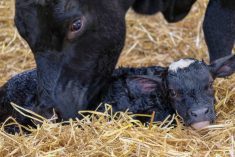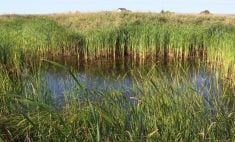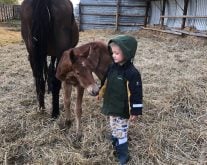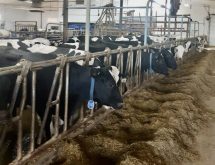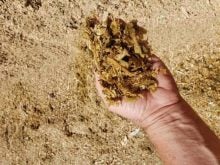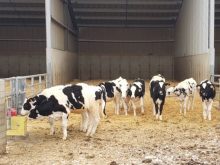I am amazed on how each summer differs in Manitoba. Two summers ago, we had severe drought, last summer was extremely wet and this year started with record heat, then cooled down to night-time single digits. Luckily, temperatures picked up again, all the while with spotty thunderstorms.
Such climatic difference presents a patchwork of knee-to shoulder-high cornfields. Once harvested, it might be challenging to balance them in silage-based lactation dairy diets unless we make sure there is a current lab analysis of each situation, so new diets are well-balanced to maintain optimum milk (and milkfat) performance.
Even before I take such samples on any farm visit, one of the first things I do is collect a sample of corn silage from the feed bunk. High-quality corn silage has a nice golden colour, smells buttery and is slightly wet. It’s the result of processing tonnes of chopped whole corn plants at about 65-70 per cent moisture and tractor-packed onto a concrete pad (bunker silo) and often covered with a thick plastic sheet to form and airtight seal.
Read Also

Harvest wraps up and fall work begins
At the Eppich famly ranch in western Saskatchewan, the fall harvest was successful with few breakdowns, cows and calves have been sorted and a new tractor has arrived
The accompanying chart below gives some of the important guidelines (source: University of Delaware) to make well-preserved corn silage:

Variable weather ahead
Neither extremely dry or extremely wet weather is ideal for producing and harvesting corn silage.
Localized thunderstorms throughout the rest of the summer will probably miss some areas and lead to a lot of dry corn silage being put up. This doesn’t make the best lactation feed, because a harvested moisture content of less than 60 per cent does not allow chopped forage to be packed tightly and exclude most air to undergo seamless anaerobic fermentation.
With drier corn, just the opposite occurs, namely undesirable bacteria: a variety of moulds/mycotoxins and penicillin-fungi thrive at these low oxygen levels and limited moisture. So it might be of no surprise that such unpalatable dry and mouldy corn silage comes out of the bunker when it is opened.
It is possible the opposite weather may occur, where thunderstorms hit areas several times with excessive rain, or we have a widespread wet and cool autumn. In both such cases, wet and immature cornfields are ensiled at a higher moisture level than the desirable 60-65 per cent.
This wet forage condition usually shifts fermentation from good lactic acid bacteria to undesirable clostridia bacteria producing large quantities of butyric acid from forage sugars and organic acids. Substantial butyric acid production in corn silage means huge forage dry matter losses and the pH of the silage may become too high (> pH 4.0) to preserve the silage. It also gives the silage an off-smell like rancid peanut butter. So when substantial butyrate-containing silage added to a TMR is fed to lactating dairy cows, dry matter intake and thus milk production suffer.
No matter on how the corn silage turns out before it is fed to lactating dairy cows, it is important to take samples for a laboratory analysis. Ask the lab for moisture, crude protein, soluble protein, ADIN, NDF, ADF, NFC and starch tests. From these analytical results, we can rebalance any type of corn silage into new lactation diets.
Last year, I balanced a dairy lactation diet for a 150-cow dairy, based upon corn-silage samples with forage analysis – DM basis of 40 per cent dry matter content (slightly dry), ADF – 18.8 per cent, NDF – 35.77 per cent, starch – 33.50 per cent and NFC – 44.70 per cent. The only other forages were two cuts of alfalfa with a Relative Feed Value (RFV) of 98 and 140. Therefore, our biggest challenge was to offset this high-energy corn silage and maintain enough dietary effective fibre.
We had strong dry matter intakes by the resident lactating cows to make up a new dairy diet that included: 1. Forage to concentrate ratio of 64 per cent; 2. Reduction of grain-corn intake by 1.5-2.0 kg and maximum limits of 4.0 kg per head; and 3. Increased bypass-protein level with 200 grams of bloodmeal. Despite some minor tweaks to this diet, it has been fed for the last nine months to yield about 40 kg of milk with a 4.21 per cent milkfat per lactating cow.
This is a good example of balancing a nutritious dairy lactation diet with whatever quality of corn silage comes out of the bunker. This year’s final corn silage should be no different, despite being a couple of months away from being ensiled. The important thing is to take forage samples to know what we are dealing with, when incorporating new corn silage into high-performing dairy lactation diets.




